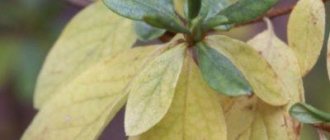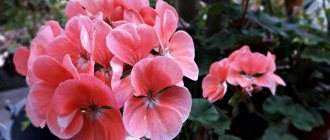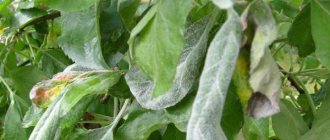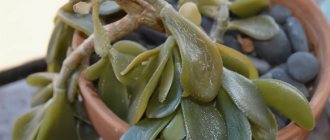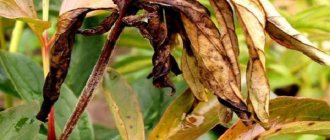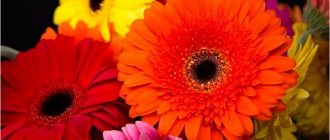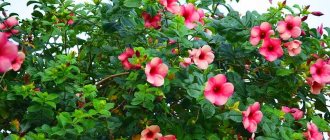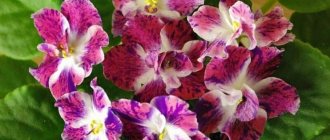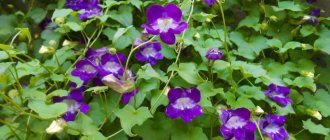Black leg in pelargonium: can the plant be cured and methods of prevention
Blackleg is the most common and nasty disease that affects pelargoniums or home geraniums.
The plant can be saved only if the infection is detected in time. Often, black leg is diagnosed when pelargonium has already died. Until this time, the disease does not manifest itself in any way. In this issue, you will find a complete guide to what to do if you notice that the geranium stems have begun to rot and signs of fungus have appeared due to waterlogging. Black leg of pelargonium is an insidious disease. It quickly infects the entire plant. Blackleg disease manifests itself abruptly. The lower parts of the trunk turn black and become soft, which is characteristic of rotting. At the same time, the blackness begins to spread to the top and quickly stains at least half of the shoots. If the disease is not treated in a timely manner, the leaves become yellow and are easily separated.
Not a single type of geranium is immune from blackleg. But, if an illness happens to your flower, then read about other varieties that are perhaps more decorative than what you had at home: rosebud pelargoniums, tulip-shaped geraniums.
The nature of yellowing of geranium leaves
If yellow spots appear on the leaves of an indoor flower, you should immediately try to understand what caused this. In this way, the plant signals a deterioration in its condition. More often than not, yellowing and drying of leaves always means unsuitable conditions or improper care. You can determine what exactly caused it by looking at the location of the spots.
Healthy geranium on the windowsill
Along the edges
Pelargonium leaves begin to lighten at the edges most often in winter. This is due to improper care of the plant during this period. If measures to restore the plant are not started in time, yellowness will descend from the top down. Treatment consists of changing conditions. It is worth familiarizing yourself with the rules on how to care for geraniums during the dormant period.
Note! The leaves may have turned yellow at the edges due to the tightness of the pot in which the geranium is forced to grow. But if these signs of poor health appear in the summer, then the cause may be insufficient watering. In hot weather it is worth performing this procedure more often, then the plant will come to life.
Yellowing of leaves around the edges
Spots
If caterpillars, whiteflies, nematodes, aphids or mites have settled on the geranium, then yellow spots may begin to appear on the leaf blade. These pests feed on plant sap. These signs occur in case of plant diseases. Depending on the type of pests and diseases, it is worth selecting certain means of treating the flower.
Light spots on the leaf
Yellowing is accompanied by wilting of the plant
If the plant begins to wilt after yellowing, then the cause is Verticellium wilt. In this case, the underside of the leaf begins to turn yellow, and then it simply dies, and the process flows onto the stem. It is not possible to save the plant after this. It is necessary to begin to act immediately after discovering the disease.
Withering
Yellowing turns to blackening
Blackening of the leaves is caused by the appearance of mealybugs on the plant. The places where they live are marked by sooty fungi that form a coating of the corresponding color. Blackened leaves begin to fall. Treatment is possible with the help of special insecticides.
Note! If the treatment procedure is carried out in an apartment, it is necessary to use personal protective equipment - gloves, goggles, a respirator. The insecticide should be used according to the instructions.
Blackening of leaves
Common causes of the disease
The main factors that provoke various diseases in geranium are:
Medicines for geranium
Geranium not only pleases with the beauty of its flowers and leaves, but also brings benefits. It is used as part of drugs that destroy bacteria, to treat runny noses and purulent wounds; the smell of the plant calms the nervous system.
To save your favorite flower from problems, the following medications are used for it:
- Aspirin - in case of detection of insects. The leaves are sprayed with a solution: one tablet is dissolved in 8 liters of water. Repeat the procedure after 20-25 days.
- Marathon - to kill insects. Water the soil with the solution a few days after planting the plant.
- Messenger. The product increases the immunity of geranium.
- Monterey. The product is sprayed to kill caterpillars on leaves and trunks.
Symptoms and diagnoses
| External signs of illness | Causes | Disease | Pests |
| Yellowing and falling leaves | Lack of fresh air, drafts or excessive watering, excess nitrogen compounds in the soil | The initial period of development of root rot | This is how mealybugs can parasitize |
| The edges of the lower leaves turn yellow and dry out | The old leaves are dying off | Nutritional deficiencies | |
| Wet areas are visible on the stems, leaves wither | Stem rot | ||
| Lack of budding, yellow leaves | Increased temperature and humidity | Nutritional deficiencies | |
| Stopping plant growth | cramped potty | Lack of nitrogen, low soil acidity | Probability of mealybugs and whitefly |
| Wilting and drooping leaves | Lack of moisture in the soil | Fungal infection | |
| Swollen, watery blisters on foliage | Excess moisture in the soil | Eden | |
| Stopping growth and flowering | Advanced root rot | Root mealybug | |
| Uneven, overly elongated stem | Lack of light | Etiolation | |
| Round spots of light color, deforming leaves | Ring spot | ||
| White coating on foliage | Powdery mildew | ||
| Leaves turn yellow along the veins | Tobacco or tomato infection | ||
| Leaves take on a brownish tint | Excess fungicide | Excess phosphorus fertilizer | |
| The plant is covered with light green larvae and flying insects. | Whitefly |
Read about why the leaves of indoor geraniums turn red and dry out here, and from this article you will learn about why the leaves turn white and how to help the plant.
Consequences of improper care
When grown indoors, geraniums have special care requirements to ensure optimal growth and prevent disease. Without proper care, indoor geraniums are vulnerable to rot and fungus. These ailments can also attract certain insect pests that typically attack other houseplants.
Rotting of geraniums occurs with excessive watering. Geranium tolerates dry soils better than excessively wet ones. And excessive watering leads to rotting of the plant. If the soil is dry to the touch at a depth of 10 to 15 cm, you can water the flower. If it is still slightly damp and cool, the plant no longer needs water.
Grow indoor geraniums in pots with drainage holes to prevent moisture from accumulating at the bottom.
Flowering failure occurs due to improper lighting. House geraniums that do not receive enough light will have fewer flowers. Keep geraniums in areas where the sun will shine most of the day. For example, on windows facing south or west. If you don't have a suitable window, move the plant outside (in summer) for a day or supplement the flower's needs with artificial lighting. In addition, the following factors can lead to the absence of flowers.
- Decrease in room temperature . If the geranium is frozen, no flowering should be expected.
- The pot size is too large, as a result of which the plant will spend all its energy on development.
- Excessive fertilization . Geraniums grown indoors usually do not require frequent fertilization. Planting geraniums in a potting mix that contains 1 part soil, 1 part sand and 1 part peat will provide enough nutrition for the first 2-3 months of growth. After this, use a water-soluble fertilizer with a nitrogen-potassium composition in equal proportions and at the rate of 1 teaspoon per 4 liters of water. If geraniums are kept indoors year-round, fertilize only during growth periods.
- Lack of nutrients in the soil.
- Violation of pruning of shoots.
Improper care can easily lead to illness. For example, swelling appears as spots on the leaves, which subsequently become corky and brown. Leaves may turn yellow and fall off. Swelling is caused by excessively wet, warm soil and moist, cool air, or is due to the fact that the roots absorb more water than the leaves. As a result, the cells swell and burst. Therefore, avoid excessive watering and hyperventilation in the apartment.
Yellowing of the leaves occurs due to insufficient watering, drying also occurs due to insufficient watering of the plant.
It is worth remembering that any violation of the rules of care contributes to the activation of pathogens of various flower diseases.
The most basic ailments
Most often, geranium is susceptible to various ailments due to poor care. The most common diseases of pelargonium are as follows:
WARNING: Fire burns cannot be treated. To save pelargonium from death, you need to pinch off all infected parts from a healthy shoot and burn them.
Geranium is very sensitive to waterlogged or unsterilized soil. When such unfavorable conditions arise, fungi, viruses and bacteria begin to parasitize it.
If infected, the diseased flower is isolated; for healthy plants, prevention is carried out, which includes the following steps:
We talked in detail about why leaf diseases occur in geraniums in this article.
Geranium can be affected by the following fungal infections:
Diseases, their photos and methods of treatment
Blackleg
This disease is a fungal disease. The damage starts from the stem. A black spot appears on it, which very quickly spreads throughout the entire stem. As a result, it breaks and the plant dies. The cause of the disease may be:
- lack of drainage;
- excessive watering;
- heavy soil.
Blackleg cannot be treated. When the first signs of disease are detected, you need to cut off the top of the plant as quickly as possible so that it can be rooted and a new one can be grown. The rest of the geranium must be destroyed.
Gray rot
The disease manifests itself as weeping brown-gray spots that cover the stem and leaves of the plant. The development of the disease occurs due to:
- high nitrogen content;
- soil that is too wet;
- high air humidity;
- stuffiness.
Treatment is carried out with fungicides. For example, “Fundazol” or “Vitaros”. These drugs are also used to prevent the disease. It is carried out in the process of cuttings. The cuttings must be placed in a solution made on the basis of these preparations.
Alternaria blight
The external manifestation of the disease is the formation of spots with a white coating on the lower part of the leaves. As a result, the leaves curl, wither, turn yellow and fall off. The cause of the disease is excessive humidity.
To cure a plant, you need to remove the affected leaves and treat the plant with Ridomil.
Verticillium wilt
Due to lack of moisture and elevated air temperatures, verticillium wilt begins to develop. A sign of the disease is yellowed or wilted leaves and inflorescences.
To restore the plant to health, it is necessary to remove damaged parts of the plant and organize proper watering. But under no circumstances should you allow it to overflow.
To prevent the disease, treatment with Trichodermin is carried out.
Rust
The symptom of the disease is the formation of light spots with dark red dots. If you look closely, you can find a brown coating underneath.
In case of weak infection, when a small area of the plant is damaged, you need to remove the infected part and treat the plant with a fungicidal agent. Treatment is carried out twice with an interval of two weeks.
If this does not help, then you need to cut off part of the geranium for cuttings, and destroy the remaining plant.
Late blight
If you find limp and curled leaves or dark sunken spots on your pelargonium, then your flower is suffering from late blight. If the plant is located in a damp room, then a white fluffy coating may form on these spots. It is almost impossible to detect the disease in the early stages, so most often the flower cannot be cured.
If a small area is infected, it must be removed and the plant transplanted into new soil. As a preventative measure, the following treatments are carried out:
- "Ridomil".
- "Profit Gold".
- "Previkur."
Bacterial spot
It primarily affects the lower parts of the leaves. At first, barely noticeable spots appear on them. After a few days they become clear and the leaves begin to curl. Next, necrosis develops, due to which the leaves dry out and fall off. Fungicides are used for treatment.
Dropsy
If watering is not organized correctly, the plant may suffer from dropsy. This happens when very dry leaves are poured generously. The mouths of the leaves, located on their back side, fail and crack. Then they become callous and look like scars.
To save the plant, you just need to remove the damaged leaf plates, and in their place new leaves will grow that will not suffer from the disease.
Late blight of geranium
The plant stops blooming, quickly withers and rots, the leaves dry out. On the roots of a dead flower you can see spots with a depressed structure. She reaches up. Damaged areas are covered with gray mycelium. The pathogen is stored in the soil.
The cause of the disease is improper care. Too dense plantings, poor lighting, high air temperatures, too wet a substrate and a large amount of fertilizer - this is why the plant can get sick. All this prevents you from growing a good healthy plant.
To avoid disease, it is necessary to use loose substrates of exceptionally high quality and follow the rules of adequate ventilation. When the first signs appear, watering is stopped and treatment is carried out with Profit-Gold, Ridomil or Previkur. These products are considered the most suitable for pelargonium kept at home.
Treatment of diseases
Blackleg. The stem darkens and rots. Infected cuttings are pinched off and the cut top is rooted.
Gray rot . It occurs on peduncles, leaves and stems. For resuscitation, remove all rotten parts, temporarily do not water or feed the geranium. Treatment is carried out with solutions: Fundazol or Vitaros.
Late blight (late blight). Fungal spores enter the plant from the soil, tubers, and plant tops. Indoors, spores are transferred to other flowers from the leaves by drafts. The cause of the fungus is excess moisture and dense soil. The soil in the pot needs to be updated and the pelargonium treated with such products as Ridomil, Previkur or Profit Gold. In winter, the flower indoors is set to the lowest possible temperature and the number of waterings is reduced. Equipment and pots after diseased bushes should be thoroughly sterilized.
Chlorosis . With a deficiency of iron and/or manganese, geranium may develop chlorosis. Then growth slows down and the color of the leaves changes. The bush needs to be transplanted into fresh soil and fertilized with a full complex of mineral fertilizers.
Etiolation. Low lighting leads to elongation and deformation of the trunk, smaller leaves and loss of their former color. In summer, the flower pot should be placed on the sunny side, but provided with partial shade during the daytime sun. In winter, artificial lighting will be required.
Eden . Even when absorbing water from waterlogged soil, pelargonium does not completely evaporate all excess. Then she gets edema. To prevent this from happening, you need to provide it with drainage not only in the pot, but also place a tray with expanded clay or broken bricks under it. After drying the soil, reduce the number of waterings and regularly ventilate the room.
It is important to know! Leaves turn yellow when there is an excess of nitrogen in fertilizers, and dry out as a result of oversaturation with phosphorus. It is necessary to replant the geranium in fresh soil, limit nutrients with these microelements, and add stimulants to the soil: zircon or epin. Do not oversaturate the soil with herbicide when fighting weeds and with fungicide when treating rot. These drugs worsen the life of the plant and lead to loss of foliage.
Flower pests
It is necessary to note a considerable number of geranium pests. Usually their occurrence is associated with increased dry air. Not only do they spoil the leaves by eating them, but they also provoke infections.
The smell of fragrant geranium is a unique way to combat aphids. These pests do not settle on pelargonium because of the smell that kills them. It’s not for nothing that experienced gardeners keep a pot of geraniums next to other flowers.
Whitefly
The whitefly is not as dangerous as its numerous larvae, which, feeding on the leaves, destroy the flower. A special product "Aktara", intended for watering, will help get rid of pests.
Spider mite
To combat this pest, we recommend removing all curled, damaged leaves. Wash the leaves of the flower with warm soapy water, and then cover the plant and pot with a plastic bag for 2-3 days. High humidity will kill ticks.
Termites
Termites are not at all dangerous for young geraniums, as they like to gnaw on the woody stem. Insecticides will help fight them. Please note that this type of medication is dangerous for pets. If there are cats, dogs, or birds at home, be vigilant.
Nematode
A real scourge from which there is no escape. The parasite promotes the formation of nodes on the roots. Treatment is impossible: the plant, pot, soil must be destroyed.
Root mealybug
The root bug settles in excessively wet soil and destroys the root. Then the stem is affected and the leaves begin to curl. In this case, only a transplant can help. The roots are thoroughly washed under running water, removing damaged ones, and planted in a new container.
Mealybug
The mealybug feeds on pelargonium sap, leaving sticky white clumps on the plant. Wipe the affected areas with a wet sponge and then spray with your homemade solution. To do this, take 20 ml of alcohol, 20 g of laundry soap and 1 liter of warm water - mix thoroughly (until completely dissolved).
Caterpillars
Caterpillars settle on geraniums if they are planted in open areas. The first sign of their appearance is holes on the foliage of the flower. Caterpillars are able to eat leaves until they destroy the plant. Experienced gardeners know how to get rid of caterpillars. For this they use the drug “Lepidocid”.
And here you can see a photo of geranium affected by diseases:
Source
Prevention
Almost all diseases and problems of pelargonium arise due to violations in care, so to prevent them you just need to follow simple rules:
- Maintain the correct temperature;
- Control air and soil humidity;
- Control lighting;
- Regularly feed the soil;
- Control the occurrence of pathologies in the plant;
- Fight insects.
Among insects, you should pay special attention to spider mites, whiteflies and aphids. They often appear in places with dry air and are carriers of infections and viruses. If these insects are found in the room where flowers grow, it is necessary to wash the plant and treat it with insecticides.
Pelargonium is sick: we diagnose, treat and revive bookmarks 5
This beautiful and unpretentious indoor, and if desired, garden plant with fragrant feathery or rounded leaves, with clusters of red or pink flowers, was loved by our great-grandmothers. We are, of course, talking about geranium, which is now more often called pelargonium. Previously, it was believed that this flower rarely got sick, and they didn’t bother with its treatment: after all, it’s very easy to grow a new bush from a cutting. Now pelargonists are actively discussing diseases and methods of treating their favorite plant at home, and everyone has a “green first aid kit.” What and why can indoor pelargonium be sick and how to help it?
Treatment
Let's look at some successful methods of how to deal with various diseases of geranium.
Disease
Prevention and Treatment Measures
Avoid overhead watering. Remove and destroy crop residues. To save the plant, apply a fungicide.
To combat and prevent diseases, buy healthy cuttings or grow plants from seeds. After diagnosis, it is necessary to immediately get rid of infected plants in order to prevent re-infection. Avoid overhead watering.
Buy healthy cuttings from a reputable grower or grow plants from seeds. Remove infected plants and cuttings.
Use sterile media for propagation. Discard infected cuttings, as affected root cuttings will later develop root rot, which will need to be treated again.
Avoid any damage to plants. Remove and destroy dying flowers and leaves. Place plants to allow good air circulation and low humidity. To revive the plants, apply a fungicide. Using only one chemical can result in the development of populations that are resistant to that chemical. Don't rely on just one chemical.
The plant must be provided with good air circulation. Avoid overwatering in cool, cloudy weather.
Buy disease-free cuttings. Do not overwater geraniums and always keep the surface of the leaves dry.
For this disease, try treating the plant with a fungicide. If there is no result, feel free to throw away the diseased specimen.
Buy healthy cuttings and do not use overhead watering. Avoid buying geraniums late in the season.
Verticillium wilt of pelargonium
Use sterile potting mix and promptly destroy infected plants.
Buy plants from trusted manufacturers. Unfortunately, almost all viruses cannot be treated.
Geranium, like its relative pelargonium, is often grown at home for decorative purposes. The plant requires special care and proper care in order to bloom and delight the owner. If these rules are neglected, the geranium will soon begin to get sick and often die.
Therefore, many are wondering how to care for pelargonium so that it is healthy, produces abundant flowering and is not susceptible to various diseases. This will be discussed below.
Home conditions for pelargonium
Pelargonium (aka geranium), which is grown on windowsills, is a native of the South African savannas. And like all Africans, she loves the sun and warmth very much, but has a negative attitude towards soil that is too nutritious and too wet. Rain is rare in the savannah, and the land there is poor.
In indoor floriculture, three types of pelargonium are known: zonal, royal (or royal) and ampelous. It is the zonal, or garden, geraniums that are planted in flower beds in the spring. They bloom for a very long time and reproduce without problems from cuttings. Royal pelargoniums are more whimsical. Their flowers are larger and more interesting than those of the zonal ones, but the flowering period is shorter and they are more difficult to reproduce. Ampelous geraniums are the most delicate and complex. But in general, pelargoniums are not very demanding and grateful flowers.
The characteristics of flowering southerners must be taken into account when growing them at home. Place pelargonium window sills on the south, east or west side. Plant it in a cramped pot so that it blooms better, give it not very nutritious soil with a good drainage layer.
Water rarely, but a lot, when it grows and blooms. But do not allow water to stagnate, remove excess water from the pan. In winter, only lightly moisten the soil; it should have time to dry out between waterings. There is no need to spray pelargonium; in nature it is not spoiled by high humidity. On the contrary, pubescent leaves can get sick if drops get on them. Be careful with fertilizing. Pelargonium can get sick from both lack of nutrition and excess. So keep your balance.
Blooming geranium needs fresh air all year round; ventilate the room where it grows. This is a good prevention of fungal diseases. In the summer, give the flower walks: put it in the fresh air or even plant it in open ground. The geranium will literally bloom there. In the fall, bring the whole plant or its cuttings home again.
Organize cool wintering, optimally from +10 to +15 degrees. And in winter, just as in summer, pelargonium needs plenty of light. If there is a deficiency, the leaves will be small, and flowering will be sparse or buds will not form at all. If there is not enough sun, artificial lighting (phytolamps, fluorescent or LED) will help.
Indoor geranium responds well to pinching and pruning. Form a fluffy bush in spring and summer, trim pelargonium for rejuvenation. And be sure to remove faded flower stalks so that new ones appear.
But don’t rush to transplant pelargonium from pot to pot. This plant is not prone to changing places. After relocation, she may turn yellow and become depressed so that resuscitation is required.
Common causes of yellow leaves in geraniums related to care
Lack of proper care can lead to the fact that the plant will not bloom or even begin to fade. It is not enough to plant geraniums in accordance with the instructions if certain rules are not followed.
Too infrequent or frequent watering
Why do hydrangea leaves turn yellow and the edges dry out - causes and treatment
Swampy soil is not the best option for the development of geraniums, but it also does not like completely dry soil. It is recommended to moisten the soil as the top layer of soil dries.
Important! In the fall, it is necessary to start reducing the amount of watering, since in winter it is needed to a minimum.
No drainage layer
Drainage prevents the formation of a swamp in a flower pot. Caring for geraniums at home will be much easier if you add a layer of expanded clay or crushed stone to the bottom of the pot.
cramped potty
You need to select a flower pot based on the size of the plant’s root system. Geranium begins to respond to lack of space by yellowing the foliage. This is due to the fact that the soil does not only have enough nutrients, but also air for the flower.
Tight pot for geraniums
Errors in care during the flower dormancy period
In winter, the flower must be kept in certain conditions, which differ from those necessary during the growing season. First of all, you should take the flower to a cooler place, protecting it from drafts. It is not recommended to place a pot with a plant near heating elements. Also, do not be overzealous with watering. The amount of water and frequency should be reduced, since less is required during the rest period, especially in a cold environment.
Lack or excess of fertilizing
The amount of mineral components in the soil is constantly running out, and therefore they need to be replenished from time to time. Depending on the time of year and the life cycle of geranium, it requires fertilizers of different compositions. In spring, nitrogen is more needed, and in summer - potassium and phosphorus.
Note! It is not always necessary to feed a plant if its leaves have turned yellow. Perhaps this is a reaction to excess minerals in the soil.
Incorrect placement of geraniums
It is worth taking care of the correct placement of the flower pot in the house. Although geranium loves sunlight, it needs to be dimmed a little. Fresh air is good for the plant, but you should not place the flower in a draft because of this.
In winter, it is worth taking the geranium into a cool room, but in this case you should not leave it on the windowsill, since the sheets touching the glass can cause frostbite. Being near heating devices is also harmful.
High air humidity
Air humidity should be in the region of 50-60%. When this level decreases or increases, geranium begins to feel unwell and signals this by yellowing of its foliage. When conditions normalize, this reaction will disappear.
Errors during transplantation
Any flower experiences stress when transplanted. After this procedure, it is worth observing the plant more closely.
Important! It is recommended to reduce the number of replantings to a minimum and only do them in extreme cases, since the geranium can be damaged or the substrate may be chosen incorrectly.
Substrate preparation
It is recommended that you undertake the preparation of the soil yourself. If this is not possible, it is worth purchasing a special substrate for hanging plants. The soil should be moderately loose, slightly acidic or neutral acidity. It is worth making sure that there is a drainage layer in the pot. To prepare the substrate, you will need to take equal amounts of humus, turf, peat and river sand.
Note! When replanting, it is necessary to inspect the root system, carefully shaking off excess soil from it. It is recommended to cut off damaged roots with sharp scissors or a knife, and treat the cut areas with charcoal.
The transplantation procedure is required after a 2-hour break after abundant watering.
Why do pelargoniums start to get sick more often?
Once upon a time, flowering geraniums were considered very healthy plants and resistant to all sorts of ailments. Probably the fact is that flower growers did not even try to understand why the leaves suddenly turned yellow or red, and the buds and flowers withered. They simply broke off a branch and grew a new healthy plant, and threw away the old one. Now pelargonium has become more expensive, both figuratively and literally. Flower lovers become attached to their pets and do not want to lose them. And varietal types of pelargonium are not so little worth throwing at them.
At the same time, with the development of home floriculture, plants developed diseases that our grandmothers, who grew geraniums on the windowsill, did not even suspect. Oddly enough, progress is to blame. New varieties of pelargonium are very decorative; they bloom more brightly. And at the same time, they are more delicate and more easily infected with fungal or viral infections, and suffer more from care errors and metabolic diseases. Plant immunity has become much weaker. And fungi, viruses and pests are hardened, they mutate, adapting to modern drugs, and increase resistance. So it turns out that pelargonium lovers are forced to acquire special medicines and reference books to treat their flowers. But it is not all that bad. Pelargonium, which has been created in optimal conditions and is adequately cared for, will be healthy and certainly bloom.
Parasitic insects and their control
Pests attack an initially weak plant, achieving its complete death. The main parasites that affect geraniums are:
- Root mealybug . Appears if the soil is very moist. The insect eats the root system. To rehabilitate geraniums, the affected roots are cut off, after which the plant’s roots are immersed in hot water for several minutes. Then they are dried and sprinkled with charcoal. The root treated in this way is transferred to sterile soil.
- Mealybug . The pest looks like white lumps that suck the juices out of the plant. First of all, you need to isolate the flower and remove the white lumps with your hands. After this, spray the plant with a soap-alcohol solution.
- Whitefly . It can be found on the inside of the leaf. To remove it, the medicine Aktara is often used.
- Aphid . Most often it affects young plants. Its habitat is shoots, leaves and stems. Pests can be removed manually or by cutting off the affected stem.
- Caterpillar . The insect makes multiple holes in the stems into which it lays larvae. In this case, the drugs Senpai or Lipidocida help.
We invite you to watch a video about pelargonium pests:
Diseases and pests of pelargonium
Diseases of pelargonium can be divided into two large groups: non-infectious and infectious. Non-infectious diseases cause violations of the rules of care and metabolic processes of the plant. These are hypothermia, swelling, deficiency or excess of microelements, a reaction to chemicals. Infectious diseases are the result of infection by a fungus, bacteria or virus; these are various rots, spots, rust, powdery mildew, and blackleg. Such diseases are dangerous because they are easily transmitted from flower to flower. Therefore, when an infection is detected, it is necessary to urgently take quarantine measures to prevent infection and epidemics.
Pests are not too fond of pelargonium. For example, a punishment for flower growers - spider mites or scale insects rarely attack geraniums. Perhaps the specific aroma of the essential oil contained in the foliage of most plant species repels insects. But whiteflies, aphids, mealybugs and rootbugs are not bothered by this feature. And in the summer, when kept outside, geraniums are attacked by caterpillars.
Pests
In addition to diseases, indoor geraniums are also susceptible to attacks by harmful insects.
- Whitefly. This is a small white butterfly that harms the plant. The adult and its larvae consume the sap of the plant, damaging it. The leaves become colorless, perform their functions poorly, and the plant gradually disappears.
- Aphid. These green flies are an even bigger problem than whiteflies, as they can destroy leaves and spread quickly. Spray the entire plant with a special spray, especially under the leaves. If possible, it is best to isolate the plant to stop the spread of aphids. Or spray absolutely all the flowers in the house to protect them.
- Sciarides. These are black midges that can be seen on the soil surface. Their larvae damage the roots. They can thrive in peat composts, but are usually not active enough to kill plants. Their life cycle lasts for about two months a year. And along with the flies, troubles disappear. If there is no time to wait, any insects are successfully destroyed with insecticides.
- Caterpillars. It is impossible to say exactly which caterpillar can attack geraniums, because they come from a variety of insects. They feed on leaves by gnawing holes in them. Control measures are the same insecticides.
Worms, snails, slugs and mites rarely attack geraniums.
Phytocontrol measures
It is easier to prevent a disease than to cure it; this principle of prevention also applies to plants. And her main rule is hygiene. A plant free from diseases and parasites and clean soil will be the key to healthy pelargonium. A flower can pick up an infection or parasite anywhere: in a nursery, in a store, in the soil. To protect your green pets, introduce home phytosanitary control. These measures will ensure the safety of the plants.
Diseases that cause yellowness and dryness of foliage in geraniums
Spathiphyllum - leaves turn yellow: causes and treatment
Yellowing of the leaves can be caused by the presence of certain diseases in the plant. If midges begin to fly over the flower, the cause is waterlogging of the soil. In this case, it is necessary to exclude watering for a while so that the substrate dries out. Against pests, it is worth adding the drug Grom-2 to the soil.
Verticillium wilt is found in soil where it can persist for up to 10-15 years. The spread of the disease will stop if the plant and shoots are removed. It is worth adding a fungicide to the soil. Replanting geraniums will not help in this case, since it is almost impossible to completely remove the substrate from the root system.
Geranium diseases, treatment and prevention
Pelargoniums most often get sick due to waterlogging of the soil. It is the flooding of the plant that gives impetus to the development of various types of rot and spotting. The disease progresses especially quickly if the room is stale, stale air, too cold or, conversely, too hot. Pelargonium gets sick from a deficiency of microelements, but also from overfeeding. These problems weaken the immune system. As a result, the plant becomes more easily infected with fungal or viral infections.
Problems caused by metabolic disorders and care errors
Diseases related to care and metabolism are not contagious. Plants with etiolation, chlorosis, deficiency or excess of nutrients are not sent to quarantine. But these ailments cannot be left without treatment, because sooner or later they will lead to more serious problems.
Etiolation is a disease of light deficiency. If pelargonium does not have enough light, it stretches unsightly, the leaves become smaller and lighter. Such a plant will not bloom. It is not difficult to cure: place the geranium on the sunny side, and in winter add artificial lighting. Just be careful, get used to bright light gradually so that there are no burns. In addition, for the harmonious formation of a flower, it is useful to turn it towards the light with different sides.
Edema, or edema, mainly affects ivy-leaved pelargoniums, less often other species . The cause of the disease is non-drying soil combined with cold and humid air. The roots absorb water, but the leaves do not have time to evaporate it.
The tissue ruptures and watery pads form on the underside. Affected leaves die or lose their decorative properties. The pads enlarge and become coarser, acquiring a brownish color. Therapeutic measures include drying the soil, adjusting watering, and reducing air humidity. Prevention - good drainage and fresh air.
Chlorosis is a disruption of the process of photosynthesis. Symptoms of the disease are changes in leaf color and slower growth. Usually, when talking about chlorosis, they mean iron deficiency. But in pelargoniums, the lack of other chemical elements also affects health and appearance. For example, a deficiency of magnesium causes yellowing of the center of the leaves, a lack of manganese causes a green mesh to appear along the veins with yellowness inside, the edges of the foliage turn white from a lack of nitrogen.
In all cases, there is only one solution - to choose a mineral complex containing the necessary components. For example, iron chelate (Antichlorosin) for deficiency of this element. Or a fertilizer balanced in composition.
Pelargonists note that the preparations Uniflor-Rost, Uniflor-micro, plant regenerator Pokon Green Power, Agricola Aqua for yellowing of leaves have proven themselves well.
But no less than a deficiency of nutrients, their excess is harmful for pelargonium. Too much nitrogen in the soil will cause the leaves to turn yellow; too much phosphorus will cause the edges to become brown and dry. Therefore, it is better to slightly underfeed the geranium.
Metabolic problems can also be solved by transplanting pelargonium. The right substrate should have everything you need for growth and health.
Geraniums find it difficult to take root in a new place. Immediately after transplantation, they need gentle care. Pelargonium is placed in a warm place. Shade from direct sun. Water moderately; unestablished roots easily rot. No spraying is necessary. You can add stimulants to irrigation water: epin or zircon.
Pelargonium can get sick after using herbicides or fungicides. The former are used to control weeds in open ground, the latter - to treat rot. In this case, transplantation or gentle transshipment will help. may have to get rid of the affected foliage, but it will grow back. The main thing is the condition of the root. If it is healthy, the plant can be treated.
Infectious diseases
A fertile environment for the development of pathogens of infectious diseases is waterlogged and unsterilized soil. Various fungi, bacteria and viruses multiply there quickly. Pelargonium that has contracted an infection must be isolated. If a green patient is left among healthy people, everyone can become infected. Some infections are so fleeting and dangerous that immediate destruction of the diseased plant is required.
Prevention of infectious diseases:
Fire blight is leaf damage caused by different types of microorganisms. Dry spots appear, leaves become deformed. Another manifestation is that when the leaves wilt, they droop like an umbrella. The plant stops growing. In this case, the root system does not suffer. Ways of transmission of infection are through splashes of water, dirty tools during pruning, through soil, and insects. The disease has no cure. Try to root the uninfected parts. The rest should be packed in a bag and thrown away, or better yet, burned.
Do not wait for the foliage to completely turn yellow; cut the plant as soon as possible. But keep in mind that limp umbrella leaves can also be a sign of dry soil.
Viral diseases cause a peculiar mesh pattern on the leaves. It usually appears during the cold season, when the defenses weaken. Leaves affected by the virus look picturesque. And yet it is a disease. The plant lags behind in development, but can live a long time. There are specific viruses characteristic only of pelargoniums; tomato and tobacco viruses are especially common. Viral infections cannot be treated. The gardener has three options: destroy the plant, remove variegated leaves, or grow pelargonium with an unusual color. If you decide to save a flower, be careful: keep it at a distance, do not use the same tools to trim diseased and healthy plants. The virus can be carried by insects.
The viral infection that causes crocodile spot is now being used to develop new varieties. Plants are infected for decorative leaves.
Fungal diseases
If the rot has affected only a small part of the roots, follow these steps:
Rot and other infectious diseases
Mr. Summer resident informs: first aid for geraniums and prevention
Indoor geraniums with yellowed leaves can be saved. Tips for quickly helping pelargonium:
- when replanting, inspect the roots for rot or disease, if damaged, wash with a weak solution of potassium permanganate, and completely change the soil;
- a pot with a flower in autumn and winter is placed further from heating radiators, it can be taken out to a glazed balcony (if the temperature there does not drop below +12 °C);
- pour soft water over it, let it sit for a long time and add a pinch of citric acid or lemon juice (3-4 drops);
- constantly inspect for damage by insects and fungi, and take timely measures to get rid of them;
- the soil is chosen in the store; it is a universal soil for indoor plants;
- if the surrounding air is dry, do not moisten the pelargonium from a spray bottle; it is best to place a cup of water or wet expanded clay next to it;
- feed regularly, since the flower is sensitive to the lack of nutrients (choose complex fertilizers in the store);
- In order for pelargonium to bloom magnificently, pruning is done in the spring, leaving a few shoots;
- if the plant stretches to one side, the pot is turned to the sunny side with different sides;
- Before watering, loosen the soil; the root system of pelargonium needs oxygen;
- in winter, they carefully watch so that the leaves do not touch the cold glass, as a result they dry out, turn yellow and fall off prematurely;
- on a hot summer day on the sunny side, the window is shaded with a sheet of paper or a piece of gauze;
- if the window sill is cold in winter, to insulate the roots, place a wooden kitchen stand, a towel, and several layers of woolen fabric under the pot;
- if there is no drainage layer in the pot with geraniums, and replanting will not happen soon, then regularly pierce the ground in several places with a hot knitting needle;
- in winter, cover the batteries with a damp thick towel, this will get rid of the increased temperature in the room and too dry air for pelargonium on the windowsill;
- A good container for indoor geraniums is a ceramic pot. Porous clay allows air to pass through, excess water evaporates faster, and air flows to the root system.
Beautiful green leaves of pelargonium indicate the health of the plant and proper care. Changes in color indicate diseases, pests or bugs.
